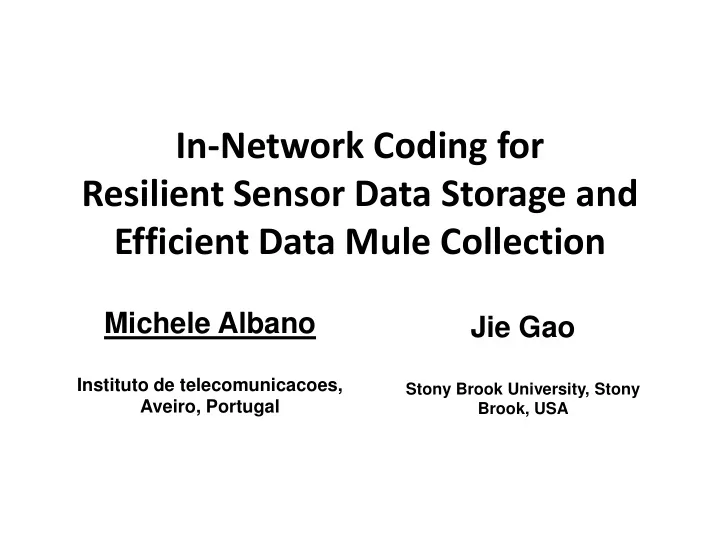

In-Network Coding for Resilient Sensor Data Storage and Efficient Data Mule Collection Michele Albano Jie Gao Instituto de telecomunicacoes, Stony Brook University, Stony Aveiro, Portugal Brook, USA
Data collection • Gather sensor data to a base station • Traditional approach: – Build aggregation tree rooted at the sink – E.g., TinyDB family. – E.g., TinyDB family. • Problem: – Sensors near sink are overloaded. – Sink disconnected from the network prematurely. • Our approach: mobile sink , or, data mule .
Data collection using mules • Network of n nodes, with k of them have data. • Data mules tour around to pick up data. • Challenge #1 : path planning Challenge #1 : path planning – TSP or multi-TSP problem, NP-hard. – Random walk. • Coupon collection • O(n 2 ) hops to cover all nodes.
Data collection using mules • Network of n nodes, with k of them have data. • Data mules tour around to pick up data. • Challenge #2 : information brokerage • Challenge #2 : information brokerage – Mule is not aware of the data nodes. – In any predetermined scheme, mule may visit many nodes without data. – Need data processing, i.e., data nodes initiate certain actions
Our approach: in-network coding • Sensor data are stored in encoded format in the network. • Original data: symbols s 1 , s 2 , …, s k . • Coded data: codewords w , w , …, w . • Coded data: codewords w 1 , w 2 , …, w n . • We use random linear coding: – Codeword = random linear combination of symbols, w j = ∑ k i=1 s i λ ij . – Every node keeps a different codeword.
Data mule collection and decoding • Data mule visit any k nodes and collect k codewords symbols can be recovered. [ ] • If the coefficient matrix is full rank, the s [ � ij ] =w symbols can be recovered. • Main focus: how to build codewords in distributed and communication efficient manner?
Gossip algorithms • In a round, each node: – Selects another node randomly – Exchanges information via multi-hop routing – Repeats every round – Repeats every round • Simple • Distributed • Robust to link dynamics, transmission errors 7
Types of gossip • Uniform/Geographic gossip – Select a node q uniformly randomly and gossip [Dimakis, Sarwate, Wainwright, IPSN 06] • Spatial Gossip – Select a node q at distance r with probability 1/r α . [Kempe, Kleinberg, Demers, STOC 01] 8
Communication cost • Uniform/Geographic gossip – Cost per step ~ O(n√n) – # rounds for a message to reach everyone ~ O(logn) • Spatial Gossip Spatial Gossip – Prob=1/r 2 , cost per step ~O(n√n) – Prob=1/r 3 , cost per step ~O(nlogn) – # rounds for a message to reach everyone ~ O(logn) 9
Spatial gossip for in-network coding • Nodes proceed in synchronous rounds • Each node p: 1. Multiply its current data by a random coefficient; 2. Send it to node q chosen by spatial distribution; 2. Send it to node q chosen by spatial distribution; 3. Store linear combination of all data received. Use total O(log 3.4 n) rounds. • Total communication cost = O(n log 4.4 n) •
Theorems • Theorem: The codeword at each node has a non-zero coefficient for any symbol w.h.p. • Theorem: Any k codewords can decode for the original symbols with prob → 1 if n → ∞. original symbols with prob → 1 if n → ∞. • Mule can successfully decode by picking up any k codewords!
Simulations • 700 nodes in a square region • Compare 4 schemes: – Uniform gossip v.s. spatial gossip – Disseminate codewords v.s. symbols. – Disseminate codewords v.s. symbols. • Major metrics to evaluate: – Decoding success rate – Communication cost
Frequency of correct reconstruction Spatial coded gossip
Routing cost in hops Spatial coded gossip
Frequency of correct reconstruction # gossip rounds for correct reconstruction: Total routing cost for correct reconstruction: Uniform non-coded – 230 rounds Uniform coded – 10 rounds Uniform non-coded – 353,000 hops Uniform coded – 90,000 hops Spatial coded – 20 rounds Spatial non-coded – Too many rounds Spatial coded – 30,000 hops Spatial non-coded – too high
Online reconstruction • Decode symbols as soon as possible. • Each round is composed of – ONE gossip round – ONE data collection step of the mule – ONE data collection step of the mule • Degree of a codeword: # symbols with non- zero coefficients. – grows exponentially in spatial gossip. – For online construction, degree should grow much slower.
Our heuristic for codeword degree
Collected codewords vs reconstructed symbols
Conclusions & Future Work � Combining spatial gossip with coding results in an efficient data collection mechanism � It is possible to implement online data reconstruction � What is the best threshold for code degree for online collection?
Thank you! • Questions and comments?
Recommend
More recommend